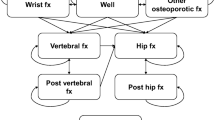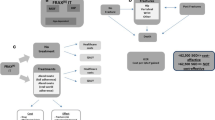Abstract
To assess the cost-effectiveness of the primary prevention of fragility hip fractures through opportunistic risk-based screening using FRAX® among women aged 70 to 89 years, and the subsequent treatment with alendronate in women at high-risk, from the Spanish national health system perspective. We performed a discrete-event simulation model. Women were categorized in low, intermediate and high-risk of fragility hip fracture through screening based on the FRAX® risk assessment tool score (Spanish version). Low-risk women received lifestyle recommendations whereas the high-risk group was assigned to alendronate treatment. For women at intermediate-risk, treatment decision was based on a recalculated score considering bone mineral density (BMD). The cost-effectiveness analysis tested six scenarios defined by different FRAX® cut-off values assessing the incremental costs per averted fracture in 20 years. Deterministic sensitivity analysis was performed. We included a random sample of 5146 women obtained from a Spanish cohort of women referred for BMD. The most cost-effective intervention had an Incremental Cost-effectiveness Ratio (ICER) of 57,390 € per averted hip fracture and consisted of using the FRAX® score without BMD and treating women with a score higher than 5%. The ICER exceeded the acceptability threshold of 25,000 € in all the scenarios. Sensitivity analysis based on time to fracture, treatment efficacy, adherence to treatment and cost of dependence resulted in ICERs ranging from 39,216 € to 254,400 €. An ICER of 24,970 € was obtained when alendronate cost was reduced to 1.13 € per month. The use of FRAX® as screening tool followed by alendronate treatment is not cost-effective in senior women in Spain. Other primary preventions strategies are advisable.


Similar content being viewed by others
References
Kanis JA, Borgström F, Compston J, Dreinhöfer K, Nolte E, Jonsson L et al (2013) SCOPE: a scorecard for osteoporosis in Europe. Arch Osteoporos 8(1–2):144
González Y, Sicras A, Larraínzar R, Sorio F, Canals L, Lizán L et al (2015) Estimación de los costes sanitarios relacionados con las fracturas osteoporóticas en pacientes posmenopáusicas en España. Pharmacoeconomics Spanish Res Artic 12(1):1–9
Sozen T, Ozisik L, Calik Basaran N (2017) An overview and management of osteoporosis. Eur J Rheumatol 4(1):46–56. http://www.eurjrheumatol.org/sayilar/209/buyuk/46-56.pdf
Blake GM, Fogelman I (2007) The role of DXA bone density scans in the diagnosis and treatment of osteoporosis. Postgrad Med J 83(982):509–517
Nayak S, Edwards DL, Saleh AA, Greenspan SL (2014) Performance of risk assessment instruments for predicting osteoporotic fracture risk: a systematic review. Osteoporos Int 25(1):23–49
Kanis JA, Oden A, Johansson H, Borgström F, Ström O, McCloskey E (2009) FRAX® and its applications to clinical practice. Bone 44(5):734–743
González-Macías J, Marin F, Vila J, Díez-Pérez A (2012) Probability of fractures predicted by FRAX® and observed incidence in the Spanish ECOSAP study cohort. Bone 50(1):373–377
Azagra R, Roca G, Encabo G, Aguyé A, Zwart M, Güell S et al (2012) FRAX® tool, the WHO algorithm to predict osteoporotic fractures: the first analysis of its discriminative and predictive ability in the Spanish FRIDEX cohort. BMC Musculoskelet Disord 13:204
Cordomí CT, del Río LM, Di Gregorio S, Casas L, Estrada MD, Kotzeva A et al (2013) Validation of the FRAX predictive model for major osteoporotic fracture in a historical cohort of Spanish women. J Clin Densitom 16(2):231–237
Shepstone L, Lenaghan E, Cooper C, Clarke S, Fong-Soe-Khioe R, Fordham R et al (2017) Screening in the community to reduce fractures in older women (SCOOP): a randomised controlled trial. Lancet 391:741–747
Hernlund E, Svedbom A, Ivergård M, Compston J, Cooper C, Stenmark J et al (2013) Osteoporosis in the European Union: medical management, epidemiology and economic burden: a report prepared in collaboration with the International Osteoporosis Foundation (IOF) and the European Federation of Pharmaceutical Industry Associations (EFPIA). Arch Osteoporos 8(1–2):136
Wells G, Cranney A, Peterson J, Boucher M, Shea B, Welch V et al (2011) Alendronate for the primary and secondary prevention of osteoporotic fractures in postmenopausal women (Review). Cochrane Libr. https://doi.org/10.1002/14651858.CD001155.pub2
Silverman SL, Schousboe JT, Gold DT (2011) Oral bisphosphonate compliance and persistence: a matter of choice? Osteoporos Int 22(1):21–26
Järvinen TLN, Jokihaara J, Guy P, Alonso-Coello P, Collins GS, Michaëlsson K et al (2014) Conflicts at the heart of the FRAX tool. CMAJ 186(3):165–167
Turner DA, Khioe RFS, Shepstone L, Lenaghan E, Cooper C, Gittoes N et al (2018) The cost-effectiveness of screening in the community to reduce osteoporotic fractures in older women in the UK: economic evaluation of the SCOOP study. J Bone Miner Res 33(5):845–851
Sanfélix-Gimeno G, Hurtado I, Sanfélix-Genovés J, Baixauli-Pérez C, Rodríguez-Bernal CL, Peiró S (2015) Overuse and underuse of antiosteoporotic treatments according to highly influential osteoporosis guidelines: a population-based cross-sectional study in Spain. PLoS ONE 10(8):1–13
Tebé C, del Río LM, Casas L, Estrada MD, Kotzeva A, Di Gregorio S et al (2011) Factores de riesgo de fracturas por fragilidad en una cohorte de mujeres españolas. Gac Sanit 25(6):507–512
Arribas D, Benítez D, Carbonell C, Cebamanos J, del Río L (2010) Guía de Práctica Clínica sobre Osteoporosis y Prevención de Fracturas por Fragilidad. Guías Práctica Clínica En El Sns. 1–263. http://www.guiasalud.es/GPC/GPC_476_Osteoporosis_AIAQS_compl.pdf
Observatorio de Salud de Cataluña. Central de Resultados. Observatorio del Sistema de Salud de Cataluña; 2018. http://observatorisalut.gencat.cat
INEbase (2016) Madrid: Instituto Nacional de Estadística. www.ine.es/inebmenu/indice.htm
Cummings SR, Black DM, Thompson DE, Applegate WB, Barrett-Connor E, Musliner TA et al (1998) Effect of alendronate on risk of fracture in women with low bone density but without vertebral fractures. J Am Med Assoc 280(24):2077–2082
Landfeldt E, Ström O, Robbins S, Borgström F (2012) Adherence to treatment of primary osteoporosis and its association to fractures-the Swedish adherence register analysis (SARA). Osteoporos Int 23(2):433–443
Severens JL, Milne RJ, Severens H (2004) Discounting health outcomes in economic evaluation: the ongoing debate. Value Health 7(4):397–401
Montserrat J, Rodríguez-Cabrero G (2002) Modelos de atención sociosanitaria. Una aproximación a los costes de la dependencia. IMSERSO. p 172. http://envejecimiento.csic.es/documentos/documentos/montserrat-modelos-01.pdf
Ley 39/2006, de 14 de diciembre, de Promoción de la Autonomía Personal y Atención a las personas en situación de dependencia de España
Puig-Junoy J, Oliva-Moreno J, Trapero-Bertrán M, Abellán-Perpiñán JM et al (2014) Guía y recomendaciones para la realización y presentación de evaluaciones económicas y análisis de impacto presupuestario de medicamentos en el ámbito del CatSalut. General Catalunya Dep Salut Serv Català la Salut Barcelona 2014:9–11
Alzahouri K, Bahrami S, Durand-Zaleski I, Guillemin F, Roux C (2013) Cost-effectiveness of osteoporosis treatments in postmenopausal women using FRAXTM Thresholds for decision. Jt Bone Spine 80(1):64–69
Kanis JA, Cooper C, Hiligsmann M, Rabenda V, Reginster JY, Rizzoli R (2011) Partial adherence: a new perspective on health economic assessment in osteoporosis. Osteoporos Int 22(10):2565–2573
Kanis JA, Borgstrom F, Zethraeus N, Johnell O, Oden A, Jönsson B (2005) Intervention thresholds for osteoporosis in the UK. Bone 36(1):22–32
Marques A, Ferreira RJO, Santos E, Loza E, Carmona L, da Silva JAP (2015) The accuracy of osteoporotic fracture risk prediction tools: a systematic review and meta-analysis. Ann Rheum Dis 74(11):1958–1967. https://doi.org/10.1136/annrheumdis-2015-207907
Järvinen TLN, Michaëlsson K, Aspenberg P, Sievänen H (2015) Osteoporosis: the emperor has no clothes. J Intern Med 277(6):662–673
Lems WF, Raterman HG (2017) Critical issues and current challenges in osteoporosis and fracture prevention. An overview of unmet needs. Ther Adv Musculoskelet Dis 9(12):299–316
Marques A, Lourenço Ó, Ortsäter G, Borgström F, Kanis JA, da Silva JAP (2016) Cost-effectiveness of intervention thresholds for the treatment of osteoporosis based on FRAX® in Portugal. Calcif Tissue Int 99(2):131–141
Nayak S, Roberts MS, Greenspan SL (2011) Cost-effectiveness of different screening strategies for osteoporosis in postmenopausal women. Ann Intern Med 155(11):751–761
Lippuner K, Johansson H, Borgström F, Kanis JA, Rizzoli R (2012) Cost-effective intervention thresholds against osteoporotic fractures based on FRAX® in Switzerland. Osteoporos Int 23(11):2579–2589
Zarca K, Durand-Zaleski I, Roux C, Souberbielle JC, Schott AM, Thomas T et al (2014) Cost-effectiveness analysis of hip fracture prevention with vitamin D supplementation: A Markov micro-simulation model applied to the French population over 65 years old without previous hip fracture. Osteoporos Int 25(6):1797–1806
Nshimyumukiza L, Durand A, Gagnon M, Douville X, Morin S, Lindsay C et al (2013) An economic evaluation: simulation of the cost-effectiveness and cost-utility of universal prevention strategies against osteoporosis-related fractures. J Bone Miner Res 28(2):383–394
Yoshimura M, Moriwaki K, Noto S, Takiguchi T (2017) A model-based cost-effectiveness analysis of osteoporosis screening and treatment strategy for postmenopausal Japanese women. Osteoporos Int 28(2):643–652. https://doi.org/10.1007/s00198-016-3782-5
Madrid: Instituto Nacional de Estadística. INEbase; 2015. www.ine.es/inebmenu/indice.htm
Pueyo MJ, Larrosa M, Suris X, Garcia-Ruiz AJ (2012) Cost-utility and budget impact analysis of primary prevention with alendronate of osteoporotic hip fractures in Catalonia. Reumatol Clin 8(3):128–134. https://doi.org/10.1016/j.reumae.2012.04.009
Acknowledgements
Xavier Surís and Marta Larrosa from Pla Director de les Malalties Reumàtiques i de l’Aparell Locomotor, and Maria Jesús Pueyo and Josep Fusté from Direcció General de Planificació i Recerca en Salut for their participation in the validation of the model. Luis del Rio and Silvana di Gregorio from CETIR medical centre for providing data. Adolfo Díez-Pérez for the insightful comments and suggestions.
Funding
This research has been produced under the collaboration agreement signed by the Instituto de Salud Carlos III, an autonomous body of the Ministry of Economy and Competitiveness, and the Agència de Qualitat i Avaluació Sanitàries de Catalunya (AQuAS), under the development of activities of the Spanish Network of Health Technology and Health Services Provision Assessment Agencies of the National Health Service, funded by the Ministry of Health, Social Services and Equality in 2012.
Author information
Authors and Affiliations
Contributions
MC and ME designed the study. MM and MP prepared the first draft of the paper. XC, CT and LD contributed to the analytical work. JL and MC were responsible for statistical analysis of the data. All authors revised the paper critically for intellectual content and approved the final version. All authors agree to be accountable for the work and to ensure that any questions relating to the accuracy and integrity of the paper are investigated and properly resolved.
Corresponding author
Ethics declarations
Conflict of interest
MM, MC, MP, JL, LD, CT, XC and ME declare that they have no conflict of interest.
Informed Consent
Research based on secondary data, informed consent was not required.
Human and Animal Rights
Research involving humans and/or animals. This article does not contain any studies with human participants performed by any of the authors.
Additional information
Publisher's Note
Springer Nature remains neutral with regard to jurisdictional claims in published maps and institutional affiliations.
Electronic supplementary material
Below is the link to the electronic supplementary material.
Rights and permissions
About this article
Cite this article
Martin-Sanchez, M., Comas, M., Posso, M. et al. Cost-Effectiveness of the Screening for the Primary Prevention of Fragility Hip Fracture in Spain Using FRAX®. Calcif Tissue Int 105, 263–270 (2019). https://doi.org/10.1007/s00223-019-00570-9
Received:
Accepted:
Published:
Issue Date:
DOI: https://doi.org/10.1007/s00223-019-00570-9




